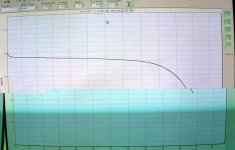pgt400
1 kW
Very nice work! Everyone appreciates your efforts!
headway said:Mr.Doctorbass,
Thanks very much! Your testings and comparisons are very helpful for us. Thanks again!
Here I have a request, I will send our 38120P 8Ah , which is the high power cell, can maintain a continuous of 10C, and 25c max. to you for testing, will you?
And may I have the below three pictures of the comparisions of HEADWAY, YESA and PSI? Please send to me by chcj55@gmail.com, thanks in advance!
VictoriaDoctorbass said:As i promissed: And... Finally the comparative graphs between these 3 cells brand:
i'll elaborate on that tomorrow morning.. now it's time to sleep!! 2:10am here.. work tomorrow :x
Good night!
Doc
Doctorbass said:As i promissed: And... Finally the comparative graphs between these 3 cells brand:
i'll elaborate on that tomorrow morning.. now it's time to sleep!! 2:10am here.. work tomorrow :x
Good night!
Doc
Ypedal said:I also sent an " Ebikes.ca " 12ah prismatic LFP cell.. :wink: ( no rush Doc, don't neglect the lady too much or she may lock the lab on you !! )
Ypedal said:exactly the same..
I have a few dead one's too.. when FalconEV sent me this pack, 2 of the cells in parallel were at 0v .. I recharged them but they only lasted a few cycles...
awesome. i want to know how my pack rates on your testbench.Doctorbass said:Ypedal.. Next test on the list: 12Ah green cell from ebikes.ca!
This is a great luck i have to get acces to every of these different cells in my lab.. I admit thatfor sure, these tests will be helping me to decide on wich i'll choose for my electric car project!
That's why i pay attention to every details about these test! I want a great test job for me too!!
The 12Ah cell is begining the first charge for the first 0.1C discharge!
Doc

Deepkimchi said:Yeah - make sure we distinguish between Andy at FalconEV and AndyH
The FalconEV 12 AH cells individually do well, but the solid copper wire connecting the cells was not a good idea, vibration makes the terminals loosen. Changing this out with stranded wire to see if it helps.
DK
Deepkimchi said:Yeah - make sure we distinguish between Andy at FalconEV and AndyH
The FalconEV 12 AH cells individually do well, but the solid copper wire connecting the cells was not a good idea, vibration makes the terminals loosen. Changing this out with stranded wire to see if it helps.
DK
Ypedal said:Awsome work Doc !!! keep it up ! ( curious to know what happens at the 50,60,70 amps range !!!) !
Yes indeed the internal resistance does change with temperature, and we even loose much capacity at -20oC. I've seen a few A123 and other cell discharge curves at different temps to see just how much the internal resistance does get worse as it gets cold.dnmun said:if you can measure the internal resistance of the cell at large differences in temperature, we may be able to tease out that part of the equation. at lower temps the ion mobility would be constrained by reduced rates of diffusion of the ions through the electrolyte. versus some quality or structure of the anode not being affected by temperature. internal resistance may not change, but it would be interesting to know.
it should not damage it to freeze it, maybe -20C, and 70C might be too late in the year to get -20C outside. does that make sense or seem worth knowing?
dnmun said:i'm not disputing anything pat, i just wondered if it was possible to calculate the IR for me at extremes of temperature. since he has 3 different chemical formulations at the same age, and history, compared on the same equipment. maybe to establish a baseline for later lifepo4 formulations.
in his original headway thread, i was able to see that IR almost tripled from initial discharge to close to terminal discharge using RLT's graphs. and i could do that too from these graphs like i did last year, but doc wants to use the IR test he established and i thought that was ok since he has good experimental technique and i think the numbers will stick for a long time.
just curious about how lifepo4 works, and why one formulation or cell type maybe is better in different situations.
and i am also curious about the charge cycle, what is the equivalent to internal resistance then? i always think about the review i read where they were talking about the theory of the supersaturating phenomena where the lithium is precipitating out of the electrolyte separated from the anode, not touching it, that has always interested me. what other electrolytes could be used sorta thing.
anyway, that's why i asked, now i included a request for IR over the discharge cycle so it doesn't make it easier for him, plus the high current runs he wants to do.
dnmun said:LifeBatt----------23.2----23.2----25.3 (added by edit using the lifebatt graph at 20A from bob's old lifebatt thread)
first 3 done at 22C by doc. if anyone gets some other numbers at different temperatures, try to keep track of where in the discharge it is so we can interpolate, thanks, dm

